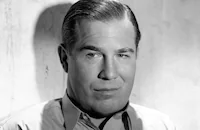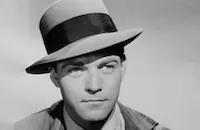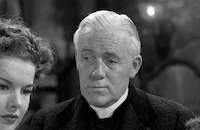The Shopworn Angel

Brief Synopsis
Cast & Crew
H. C. Potter
Margaret Sullavan
James Stewart
Walter Pidgeon
Hattie Mcdaniel
Nat Pendleton
Film Details
Technical Specs

Synopsis
In 1918, Daisy Heath, the popular star of a Broadway revue, callously dismisses the soldiers who flock to her show before they are shipped to France to fight in World War I. Daisy's manager, Sam Bailey, who is in love with her, is worried about her increasingly jaded view of life. One night, when Daisy's car accidentally bumps naive soldier William Pettigrew, she offers him a lift and Bill tries to impress his friends by saying that she is his girl. Later, when Bill puts Daisy's picture up in the barracks and brags about her, his pals trick him into arranging an introduction for them. Worried that his friends will know he has been lying, Bill goes to Daisy and begs her to help him. She is at first reluctant, but finally agrees and even goes with Bill for an ice cream after meeting his friends. When they part, she says that he can "pretend" to call her once in a while if he wants.
Soon Sam notices that Daisy's attitude toward life is softening and likes the change. One morning, when Bill calls Daisy's apartment, her maid Martha tells him that she is too sick to come to the phone. Not knowing that Daisy merely has a hangover, Bill buys flowers and candy and rushes to Daisy's apartment. He meets Sam there, who doesn't reveal his true relationship to Daisy. Although Daisy tells Sam that she is merely fond of Bill, Sam worries that her feelings are deeper. A short time later, Sam arranges for Daisy to give a show at Bill's camp. After the performance, Daisy is touched by Bill's peaceful fatalism towards death in the war and agrees to show him the sights. The next night, Bill and Daisy return to her apartment after their happy excursion on the town and Sam is waiting. After Bill leaves, Sam jealousy accuses Daisy of being in love with Bill. Daisy is shocked at his outburst and tenderly assures him that there is no need for jealousy because she only loves Bill as a friend.
The next day, Bill learns that he is being shipped out and goes AWOL to see Daisy at the theater. Though she has promised Sam never to see Bill again, she leaves the show to spend the evening with Bill. Returning to her apartment, they are again met by Sam, who is hurt that Daisy broke her promise. Not realizing how Sam and Daisy feel about each other, Bill asks Sam for his blessing to propose to Daisy. After asking Bill if she can speak to Sam alone, Daisy tells Sam that it was Bill's sweetness that softened her enough to realize her love for Sam. Because she wants to give Bill something to live for while he is at the front, she says that she must marry Bill, but promises to tell him the truth as soon as he returns. Though hurt, Sam cannot bring himself to shatter Bill's illusions and reluctantly goes to the wedding.
Some months later, while Daisy is performing in a nightclub, Martha gives Sam a letter that has arrived for Daisy from the war department, revealing Bill's death. When Daisy sees Sam's reaction to the letter, she knows what has happened, but bravely finishes singing "Pack Up Your Troubles in Your Old Kit Bag and Smile, Smile, Smile," as tears fill her eyes.

Director

H. C. Potter
Cast

Margaret Sullavan

James Stewart

Walter Pidgeon

Hattie Mcdaniel

Nat Pendleton

Alan Curtis

Sam Levene
Eleanor Lynn

Charles D. Brown
Jimmy Butler
William Stack
Hudson Shotwell
John Merton
Harry Tyler

Mary Howard

Virginia Grey
Wesley Giraud
Wade Boteler

James Flavin
George Chandler
Grace Hayle
Jack Murphy
Frank Mcglynn Jr.

Edward Keane
Mary Dees
Joan Mitchell
Frances Millen
Eddy Chandler
Paul Spiegel
Don Brodie
Roger Converse
Francesco Maran
Paul Kruger
Dorothy Granger
Crew
Adrian
George Asaf
Howard Estabrook
Cedric Gibbons
W. Donn Hayes
Joseph L. Mankiewicz
Mary Martin
Felix Powell
Joseph Ruttenberg
Waldo Salt
Douglas Shearer
Slavko Vorkapich
Edward Ward
Edwin B. Willis
Edward Woehler
Joseph Wright

Videos
Movie Clip



Trailer
Hosted Intro
Film Details
Technical Specs

Articles
The Shopworn Angel
Dana Burnet's 1918 story "Private Pettigrew's Girl" told the slim tale of a GI on his way to World War I who falls for a Broadway chorus girl who, out of pity, marries him. She even gets her gangster lover to go along with the ruse so that Private Pettigrew can go off to almost certain death with a smile. It had first been filmed, using the story's title, in 1919. Then in 1928, Paramount re-made it with Nancy Carroll as the chorus girl, Gary Cooper as the GI and Paul Lukas as her gangster lover. The film was a huge success, winning Carroll an Oscar® nomination and establishing Cooper and Lukas as leading men.
The 1928 film was still fondly remembered when MGM bought the rights in the mid-'30s, hoping to turn it into a vehicle for their resident blonde bombshell, Jean Harlow. Her death in 1937 required some frantic recasting. First Joan Crawford and one-time bit player Dennis O'Keefe were announced for the leads. But executives decided they had other things for Crawford to do and assigned the starring role to Rosalind Russell. When the studio decided they needed a strong leading lady for their British production The Citadel (1938), however, she was shipped off to England, and the role went to Margaret Sullavan, who had just signed a short-term contract with MGM. Melvyn Douglas was originally announced as her true love, but the role went to Walter Pidgeon instead. And relatively new screen actor James Stewart won the role of the naive soldier. Similar shuffling went on with the directing assignment, as the project passed from Richard Thorpe to Julien Duvivier and finally Goldwyn contract director H.C. Potter, who had just completed The Goldwyn Follies (1938).
Meanwhile, screenwriter Waldo Salt, another relative newcomer, was trying to get the story past the Production Code censors. To do so, he had to remove most of the leading lady's hard edge, in the process transforming her from chorus girl to musical star (Sullavan would be greatly helped in creating this illusion by the vocals dubbed by future Broadway legend Mary Martin). Her gangster lover became a producer with an unconsummated romantic interest in her, and Salt had to make it clear that the Sullavan-Stewart relationship remained just as pure.
But for all these problems, the studio scored a big bonus by pairing Sullavan and Stewart on screen. The two were old friends, having worked together in The University Players, a summer theatre including such other future greats as Henry Fonda and director Josh Logan. Sullavan had been one of their leading ladies when Stewart started work there as an usher in the summer of 1932. He quickly moved up to bits and featured roles, which won him his first Broadway shot later that year, convincing him to continue with acting. By the time Stewart moved to Hollywood in 1935, Sullavan was already established there as a star. She even used her position to foster his career, requesting him as leading man for the romance Next Time We Love (1936) at Universal. The film would turn him into a leading man, though his home studio, MGM, still wasn't entirely sure what to do with him. The Shopworn Angel would show them just that, as he turned in a simple, natural performance as the stammering, all-American doughboy.
The Shopworn Angel was a box office success, although it received only mixed reviews from the critics. It also led to two more teamings for Stewart and Sullavan, the anti-Nazi drama The Mortal Storm (1940) and their best film together, the gentle romantic comedy The Shop Around the Corner (1940). Although they only made four films together, their rapport has made them a particular favorite among connoisseurs of screen acting. Their teamwork may have indicated more than just friendship, at least on Stewart's part. Some biographers have claimed he carried a torch for Sullavan for almost two decades, using that to explain the fact that he never married until 1949. And when he did wed, few could miss the resemblance between his wife, former model Gloria Hatrick McLean, and Sullavan.
Producer: Joseph L. Mankiewicz
Director: H.C. Potter
Screenplay: Waldo Salt
Based on the story "Private Pettigrew's Girl" by Dana Burnet
Cinematography: Joseph Ruttenberg
Art Direction: Cedric Gibbons, Joseph C. Wright
Music: Edward Ward
Principal Cast: Margaret Sullavan (Daisy Heath), James Stewart (Bill Pettigrew), Walter Pidgeon (Sam Bailey), Nat Pendleton (Dice), Alan Curtis (Guy with Thin Lips), Sam Levene (Guy with Leer), Hattie McDaniel (Martha the Maid), Charley Grapewin (Wilson the Caretaker), Virginia Grey (Chorus Girl).
BW-86m. Closed captioning.
by Frank Miller

The Shopworn Angel
Virginia Grey (1917-2004)
She was was born in Los Angeles on March 22, 1917, and was exposed to the film industry at a very young age. Her father, Ray Grey, was a Keystone Cop and acted in several other of Mack Sennett's comedies with the likes of Mabel Normand, Dorothy Gish and Ben Turpin. When her father died when she was still a child, Virginia's mother encouraged her to join the acting game and audition for the role of Eva for Uncle Tom's Cabin, a big budget picture for Universal Studios in the day. She won the role, and acted in a few more pictures at the studio: The Michigan Kid and Heart to Heart (both 1928), before she decided to temporarily leave acting to finish her schooling.
She returned to films after graduating from high school, and after bouncing around Hollywood doing bits for various studios, she hooked up with MGM in 1938. Her roles in her first few films were fairly non-descript: In Test Pilot and Ladies in Distress (both 1938), she did little more than look pretty, but in the following year she had scene-stealing parts in The Women (upstaging Joan Crawford in a delicious scene as a wisecracking perfume counter girl) and as the suffering heroine in Another Thin Man (both 1939).
Despite her versatility (she could handle comedy or drama with equal effectiveness), MGM would cast her in some above-average, but hardly starmaking movies: Whistling in the Dark, The Big Store (both 1941), and Tarzan's New York Adventure (1942). She left MGM in 1943 and became a freelance actress for several studios, but her material as a leading lady throughout the '40s were mediocre: Swamp Fire, House of Horrors (both 1946), and Mexican Hayride (1948) were sadly the more interesting films in her post-MGM period. But by the '50s she was a well-established character actress, appearing in fairly big-budget pictures: All That Heaven Allows, The Rose Tattoo (both 1955), Jeanne Eagels (1957).
In the '60s, Grey turned to television and found work on a variety of hit shows: Wagon Train, Peter Gunn, Bonanza, My Three Sons, I Spy, and several others; plus she also captured a a couple of notable supporting parts in these films: Madame X (1966), and Airport (1970), before retiring completely from acting in the early '70s. She is survived by her sister, Lorraine Grey Heindorf, two nieces and two nephews.
by Michael T. Toole
Virginia Grey (1917-2004)
Quotes
Trivia
Margaret Sullavan's singing was dubbed by Mary Martin (I).
The costume worn by the chorus girls in the final song were used in Born to Dance (1936)'s final number "Swinging the Jinx Away".
Notes
According to news items in Hollywood Reporter, the rights to Dana Burnet's short story, "Pettigrew's Girl," were bought by M-G-M from Paramount, which had produced a version of the story under the original title in 1919, starring Ethel Clayton and Monte Blue under George H. Medford's direction (see AFI Catalog of Feature Films, 1911-20), and a 1928 version under the title The Shopworn Angel, starring Nancy Carroll and Gary Cooper, under Richard Wallace's direction (see AFI Catalog of Feature Films, 1921-30). M-G-M originally had intended it as a vehicle for Jean Harlow. In July 1937, after Harlow's death, it was announced that Waldemar Young was "to script" the picture, however, he is not credited elsewhere, and the extent of his participation in the released film has not been determined.
Joan Crawford and Dennis O'Keefe were announced as the new leads in October 1937, however, Rosalind Russell was announced as Crawford's replacement in March 1938. Late in Mar, Film Daily and Hollywood Reporter carried news items stating that although Russell was to have played the lead, studio executives decided that she should instead appear in its British studio production The Citadel, and that Margaret Sullavan should play the lead in The Shopworn Angel. A news item in Hollywood Reporter on March 28, 1938 noted that the picture was starting that day with Melvyn Douglas and James Stewart, however, a production chart on another page of the same Hollywood Reporter issue includes Walter Pidgeon in the cast, not Douglas. According to other news items, Richard Thorpe was the first director mentioned for the film, followed by Julien Duvivier. Maurice Maurice was also announced as Duvivier's aide. H. C. Potter was brought in as director in late March 1938, after having been borrowed from Samuel Goldwyn.
Harold Rosson was mentioned at that time as the cameraman, however, he was not credited on production charts or in reviews. Although William Daniels was listed as the camerman in early Hollywood Reporter production charts, only Joseph Ruttenberg is credited onscreen and in reviews. Actress Dorothy Koster's name is included in an early Hollywood Reporter production chart, however, her appearance in the completed film has not been confirmed. Sullavan's singing voice was dubbed by Broadway musical-comedy star Mary Martin. Modern sources indicate that Universal's The Rage of Paris, which was filmed at approximately the same time as The Shopworn Angel was Martin's first film "bit" role. According to records of the M-G-M Music Collection at the USC Cinema-Television Library, Martin's recording of "Pack Up Your Troubles in Your Old Kit Bag and Smile, Smile, Smile" was made on June 1, 1938.
















